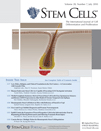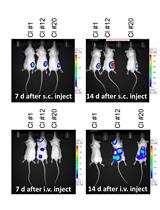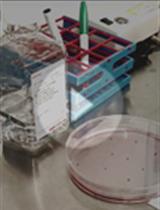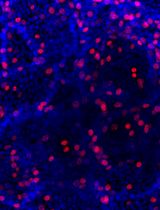- EN - English
- CN - 中文
Generation of Mouse Thyroid Calcitonin-producing Cell Tumors from Primary Mouse Tumors
从原代鼠肿瘤中生成鼠甲状腺产降血钙素的肿瘤细胞
发布: 2015年12月20日第5卷第24期 DOI: 10.21769/BioProtoc.1681 浏览次数: 8701
评审: Hong Lok LungKristopher MarjonAnonymous reviewer(s)
Abstract
Medullary thyroid cancers (MTCs) are derived from calcitonin-producing cells (C cells) of neuroendocrine origin. Rb heterozygous mice develop low-grade C cell adenocarcinoma following biallelic inactivation of the Rb tumor suppressor gene loci. Additional inactivation of another tumor suppressor gene such as Trp53, Arf or Cdkn1a allows Rb-deficient mice to generate more aggressive C cell adenocarcinoma (Takahashi et al., 2006; Shamma et al., 2009; Kitajima et al., 2015). To characterize C cell adenocarcinoma cells derived from Rb-deficient mice of different genetic backgrounds, we attempted to extract C cell adenocarcinoma cells from primary thyroid tumor tissue. Since primary mouse small cell lung cancer (SCLC) cells those originate in neuroendocrine cells that also stems C cells, can be established both as non-adhesive and adhesive cells (Calbo et al., 2011), we applied their method to MTCs. Here we describe our isolation technique for non-adhesive and adhesive cell cultures from primary medullary thyroid tumor tissue. We found that the molecular markers of C cell such as Calcitonin and Ascl1 are predominantly enriched in the non-adhesive population (Kitajima et al., 2015). This is in line with the fact that one of most commonly distributed human MTC cell line TT is non-adhesive.
Keywords: Retinoblastoma (视网膜母细胞瘤)Materials and Reagents
- 12 well cell culture plate (Thermo Fisher Scientific, catalog number: 150628 )
- 100 mm cell culture dish (Thermo Fisher Scientific, catalog number: 172931 )
- 5 ml centrifuge tube (Thermo Fisher Scientific, catalog number: 339650 )
- Phosphate buffered saline (PBS) (pH 7.2) (Life Technologies, catalog number: 20012027 )
Note: Currently, it is “Thermo Fisher Scientific, GibcoTM, catalog number: 20012027”. - 100x Antibiotic-Antimycotic (Life Technologies, catalog number: 15240062 )
Note: Currently, it is “Thermo Fisher Scientific, GibcoTM, catalog number: 15240062”. - Dulbecco’s modified Eagle's medium (DMEM) (Wako Pure Chemical Industries, catalog number: 04330085 )
- 3,000 U/ml Collagenase from Clostridium histolyticum (Sigma-Aldrich, catalog number: C5138 )
- 1,000 U/ml Hyaluronidase (Wako Pure Chemical Industries, catalog number: 08006201 )
- 20 mg/ml Deoxyribonuclease I from bovine pancreas (Sigma-Aldrich, catalog number: DN25 )
- Fetal bovine serum (FBS) (Thermo Fisher Scientific, catalog number: SH3091003 )
Note: Currently, it is “GE Healthcare, catalog number: SH3091003”. - Penicillin-Streptomycin Mixed Solution (Nakarai tesque, catalog number: 2625384 )
- 0.5 g/l-Trypsin/0.53 mmol/l-EDTA Solution, with Phenol Red (Nakarai tesque, catalog number: 3277834 )
- 7-AAD (BD Pharmingen, catalog number: 5168981E )
- CELLBANKER1 (Nippon Zenyaku Kogyo Co., ZENOAQ, catalog number: CB011 )
- Wash buffer (see Recipes)
- Digestion solution (see Recipes)
- Growth medium (see Recipes)
Equipment
- Surgical scissors and forceps
- Pipettes
- Centrifuge
- Cell culture hood
- 37 °C, 5% CO2 cell culture incubator
- Microscope
- FACS Aria ll flow cytometer (BD Biosciences)
Procedure
文章信息
版权信息
© 2015 The Authors; exclusive licensee Bio-protocol LLC.
如何引用
Kitajima, S., Li, F. and Takahashi, C. (2015). Generation of Mouse Thyroid Calcitonin-producing Cell Tumors from Primary Mouse Tumors. Bio-protocol 5(24): e1681. DOI: 10.21769/BioProtoc.1681.
分类
癌症生物学 > 通用技术 > 细胞生物学试验 > 细胞分离和培养
癌症生物学 > 通用技术 > 肿瘤形成 > 细胞分离和培养
您对这篇实验方法有问题吗?
在此处发布您的问题,我们将邀请本文作者来回答。同时,我们会将您的问题发布到Bio-protocol Exchange,以便寻求社区成员的帮助。
Share
Bluesky
X
Copy link














